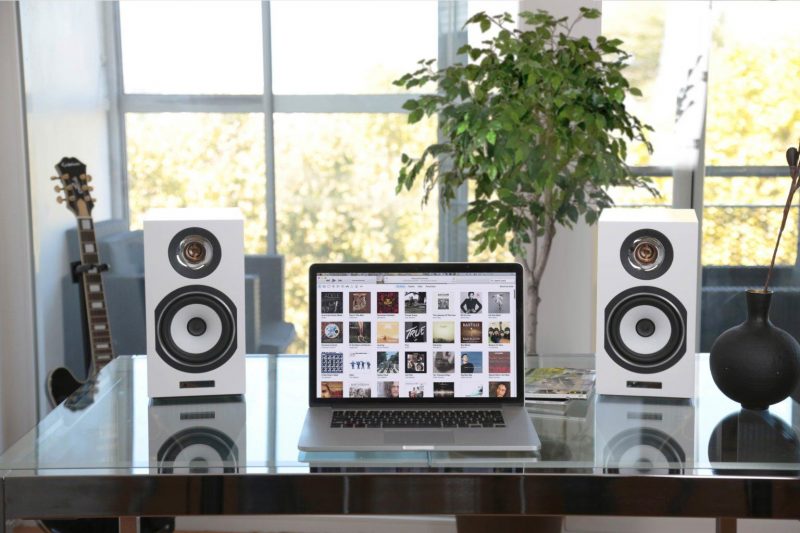Triangle is hot right now.
The French speaker manufacturer’s new budget Borea range has been a huge hit, with tons of audio reviewers singing its praises. We made the Borea BR-03 bookshelf our 2019 Product Of The Year, and What Hi-Fi? just gave it a five-star review.
Today, I’m looking at a bookshelf from the line above Borea, the $999 Esprit Titus Ez Bookshelf Speaker. The Borea speakers share paper cone woofers with the Esprit Ez models, but the latter uses an aluminum tweeter with Triangle’s signature deep horn-loading setup. Borea models use a silk tweeter with a shallow horn-loading.
The Esprit range also has a stiffer cabinet than the Borea line, which cuts down on resonance from the enclosure. The Titus EZ is the middle brother of the Esprit standmounts, with the smaller Heyda Ez slotting below it, and the larger Comete Ez sliding in above it.
The Titus EZ was sent out by Triangle in exchange for an honest evaluation; we will return it at the end of the evaluation period.
Build and Features
The speaker measures a compact 6.61 x 10.51 x 12″ (or 168 x 267 x 305mm for our metric friends) with a 5.25-inch paper cone midrange driver. That midrange is mated to an aluminum dome tweeter in a two-way configuration.
The tweeter resides in a customized compression chamber with an ornate copper phase plug placed in front to reduce directivity. That means the Titus has a pretty wide sweet spot.
It’s a relatively sensitive Bass Reflex design, with a small port in the rear and a sensitivity rating of 90db per 1 watt. Port noise is minimal even when you push it. Overall, it’s a very composed speaker even at higher volumes, which is remarkable for a standmount that’s only about a foot tall.
I partially credit the solid cabinets for their remarkable composure. A quick rap on the side elicits minimal sound or movement.
Below the port in the rear, is a single set of elegant aluminum five-way binding posts which counterpoints nicely the White gloss finish of the set I reviewed. They also come in a Black gloss finish, Black ash vinyl wrap, and a Walnut vinyl wrap.

I love the white gloss finish…I have a pair of Paradigm Monitor Atom SE in the same color, and while those look good, the gloss on the Titus EZ is of a much higher caliber.
Combine that with the chrome tweeter horn and chrome accent around the midrange driver, and you have a beautiful speaker.
The Black and White gloss versions sell for $1250, and the Black Ash/Walnut vinyl versions go for $1000.

Listening To The Esprit Titus Ez
I set up the Titus Ez on heavy metal stands about two feet from the side and back walls, then about seven to eight feet apart. They were also about eight feet from my listening position.
I experimented with toe-in, but in the end, I found pointing them straight ahead gave me the best balance of soundstage and imaging for my taste. Slight toe-in will improve focus a little, but at the expense of some soundstage width.
Like some other speakers at this price range, the Kef LS50 being one example, you must pair the Titus Ez carefully to get the best out of them. Also, like the LS50, the treble can be edgy if you pair them with an amp that’s too bright. They will benefit most from a transparent amp with a smooth treble.
I enjoyed the Titus Ez’s most with the PS Audio Stellar Gain Cell DAC and S300 Amplifier ($1699 and $1499). I connected my HP Envy laptop to the Gain Cell DAC via USB and played 24-bit music files from Audirvana.

The first thing I noticed about them is that they played big for such a compact pair of speakers. I played “Father Stretch” from Kanye West’s Sunday Service choir, one of my favorite tracks to test scale and dynamics, and the Titus was off the charts.
No, they are not going to produce earth-shattering amounts of bass, but they do provide enough to add weight to a piece. On “Father Stretch,” there is a massive horn and drum part about three minutes in, and the Titus wrecked shop playing the groove with authority. The choir stretched across my entire listening room. The soundstage and imaging were terrific.
When I put on François Moutin and Kavita Shah’s “Interplay,” the Titus’ showed off their penchant for nuance. They reproduced Shah’s complex phrasing with aplomb. You can hear her breath as she intertwines her vocals with Moutin’s accompaniment. Once again, the imaging was stellar, and I felt like they were playing in my room.
Compared to the Kef LS50, widely considered to be the gold standard at the price point, the Kef digs deeper and jumps on the rhythm of modern tracks better, but they can’t compete with the Titus’ focus and precision in the midrange. Their vocals are just a little more diffuse.
Conclusion
Esprit Titus EZ may be the most expressive and precise speaker at around $1000. If you pair them with some quality electronics, they will reward you with an immersive hi-fi experience.
Buy Here: Adorama-Triangle HiFi Bookshelf Speakers – Titus EZ, Black Ash, Pair
Also Available At These Local Dealers!
NC: https://bigkidstoysav.com/
NY: https://adkav.com/
IL: https://www.toskaaudio.com/

I’m an audio writer who started as a young audio salesman/consumer electronics professional back in the late 90s. That’s where I discovered the magic of 2-Channel sound. My thirst for great sound has led me on a delightful music quest that continues today.



Leave a Reply